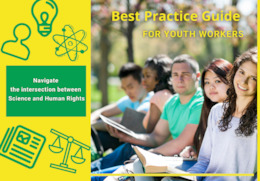Toolbox — For Training and Youth Work
All new tools in your inbox: Be the first to know about new tools for learning with our e-mail notifications.
Simulation Exercise, Exercise, Energiser, Background Text, Manual, Ice-breaker, Info session
Best practice guide for youth workers "At the Intersection between Science and Human Rights"
This guide is a resource for youth workers, which helps them to cultivate among young people a deep and responsible understanding of how science and human rights interact in their daily lives.
Aims of the tool
The guide aims to equip youth workers with skills and practical tools on how to approach science and human rights education in an integrated manner.
It aims to inspire young people to analyse the world's complex problems through the lens of science and human rights, helping them to become active and responsible citizens. Our approach is rooted in our tenet that it's essential that young people have a rationality based on sound judgment and promote a fairer and more inclusive society.
The ultimate purpose is to increase youth's civic engagement and enable them to contribute to solving social problems through local civic actions by using science and human rights knowledge as tools.
Description of the tool
The guide explains how to use non-formal methods in order to approach the interconnection between science and human rights in an integrated manner.
It presents a series of case studies and inspirational narratives, intended to encourage and equip youth workers with concrete methods and examples to engage young people in critical discussions and educational activities.
The guide is not only a document to read; it is a working tool. Each chapter is designed not only to inform, but to provoke, question and encourage dialogue. It's a resource aimed at equipping youth workers with the skills and knowledge to guide and navigate the ethical and scientific complexities of the modern world.
In times when misinformation is ubiquitous and pseudoscience is gaining ground, the need for such an initiative becomes obvious. The guide not only answers this call, but does so in a clear manner, leading the readers to a renewed understanding of their role in society.
The guide is available in the following languages: English, Romanian, Bulgarian.
Available downloads:
Disclaimer
SALTO cannot be held responsible for the inappropriate use of these training tools. Always adapt training tools to your aims, context, target group and to your own skills! These tools have been used in a variety of formats and situations. Please notify SALTO should you know about the origin of or copyright on this tool.
Tool overview

http://toolbox.salto-youth.net/4236
This tool is for
Youth workers of any age. Young people between 14 and 30 years old.
and addresses
Social Inclusion, Youth Initiatives, Project Management, Personal Development, Youth Participation
It is recommended for use in:
Youth Exchanges
Training and Networking
Materials needed:
Any didactic materials easily accessible such as: paper, pens, coloured pencils etc.
Behind the tool
The tool was created by
Romanian Secular-Humanist Association
in the context of
Erasmus+ project “For a better future: Training course for an integrated approach on science and human rights education”(project no. 2022-3-RO01-KA210-YOU-000097096)
The tool has been experimented in
Training course for youth workers (Sinaia, Romania, November 2023), Youth learning activities organised in several communities from Romania, Bulgaria and Malta
The tool was published to the Toolbox by
Patricia Fechet (on 24 June 2024)
and last modified
7 June 2024
Comments
No comments have been posted yet.
If you want to comment on this tool, you need to be signed in with your MySALTO account. Sign in now